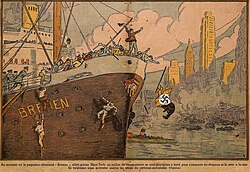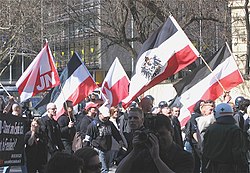Circles of latitude between the 45th parallel north and the 50th parallel north

 | |
| Use | National flag and ensign |
|---|---|
| Proportion | 3:5 |
| Adopted | 15 September 1935 |
| Relinquished | 23 May 1945 |
| Design | A horizontal flag featuring a red background with a black swastika on a white disc |
| Designed by | Adolf Hitler |
| Flag of Nazi Germany (1933–1935) | |
 | |
| Use | National flag and ensign |
| Proportion | 3:5 |
| Adopted | 14 March 1933 |
| Relinquished | 15 September 1935 |
| Design | A horizontal tricolour of black,white, and red. |
The flag of Nazi Germany, officially called the Reich and National Flag (German: Reichs- und Nationalflagge[1]), and also known as the Nazi flag or swastika flag (German: Hakenkreuzflagge – lit. 'flag with a hooked cross') featured a red background with a black swastika on a white disk. This flag came into use initially as the banner of the National Socialist German Workers' Party (NSDAP), commonly known as the Nazi Party, after its foundation in 1920.[2] Shortly after the appointment of Adolf Hitler as Chancellor in 1933, this flag was adopted as mandatory for use, while the national one was the black-white-red triband of the German Empire.[3] One year after the death of President Paul von Hindenburg, this arrangement ended. The Nazis banned usage of the imperial tricolour, labelling it as "reactionary",[4] and made their party flag the national flag of Germany as a part of the Nuremberg Laws in 1935,[1] which it remained until the end of World War II and the fall of the Third Reich.
History
[edit]Origins
[edit]The design of the Nazi flag was introduced by Hitler as the party flag in mid-1920, roughly a year before (29 July 1921) he became his political party's leader: a flag with a red background, a white disk and a black swastika in the middle. The flag was designed by Hitler himself, as described in his book Mein Kampf, in which he explained the process by which the Nazi flag design was created, after having presented several proposals:[2]
"I myself, meanwhile, after innumerable attempts, had laid down a final form; a flag with a red background, a white disk, and a black swastika in the middle. After long trials I also found a definite proportion between the size of the flag and the size of the white disk, as well as the shape and thickness of the swastika.[2]
— Adolf Hitler, Mein Kampf (1925)
The Nazi Party was not the only party to use the swastika in Germany. After World War I, a number of far-right nationalist movements adopted the swastika. As a symbol, it became associated with the idea of a racially "pure" state.[2]
Mandatory party flag (1933–1935)
[edit]Soon after Hitler was appointed Chancellor of Germany on 30 January 1933, the black-red-gold tricolour flag of the Weimar Republic was banned; a ruling on 12 March established two legal flags: the reintroduced black-white-red imperial tricolour national flag and the flag of the Nazi Party.[3][5] Despite this, the new flags were not introduced officially until 14 March 1933, although this usage may have formally started earlier.[6] On 29 April 1933, Interior Minister Wilhelm Frick decreed that all merchant ships had to fly the black-white-red ensign at the stern and the flag of the Nazi Party on the signal stay or starboard signal yard.[7]
Initially, the official specification for the Nazi flag placed the white disk, containing the swastika, in the middle of the flag. However, on 20 December 1933 a decree was issued authorising an off-centred version of the swastika flag for use at sea.[8] This was purely a practical decision intended to make the emblem more visible (because when a flag is flying briskly, the outer half appears shorter than the half next to the staff and the centred white circle would appear to be more towards the fly). Moreover, although the Nazi flag on land had the swastika on both sides "right-facing," the Nazi flag at sea displayed the swastika on the reverse side as a "through and through" or mirror image, so the flag had a "right-facing" swastika on the front (or obverse) side and a "left-facing" swastika on the back (or reverse) side. It is not absolutely known when the reverse of the swastika flag at sea was changed, but it can be assumed that this change was made as part of the regulations of 20 December 1933. The reasons were the same in each case: to improve the appearance ("optical proportions") of the flag when used at sea, and improve the visibility of the important design elements (by eliminating potential reverse-shadowing of the dark swastika on the white circle, especially in bright sun light). The German Government's publication Die Flaggen des deutschen Reiches (1934 edition) illustrates both versions of the swastika flag, referring to the centred version plainly as the Swastika Flag (German: Hakenkreuzflagge) and the off-centred version as the Swastika Flag on Merchant Ships (German: Hakenkreuzflagge auf Kauffahrteischiffen).[5][9]
National flag and ensign (1935–1945)
[edit]
On 15 September 1935, one year after the death of Reich President Paul von Hindenburg, the Nazi flag became the national flag and ensign of Germany.[1] One reason for the change may have been the "Bremen incident" of 26 July 1935, in which a group of demonstrators in New York City boarded the ocean liner SS Bremen, tore the Nazi Party flag from the jackstaff, and tossed it into the Hudson River. When the German ambassador protested, US officials responded that the swastika was not the German national flag (unlike the black-white-red tricolour) and therefore the perpetrators could not be criminally prosecuted and punished due to the absence of elements of crime, as the German national flag had not been harmed, but only a political party symbol.[10] The new flag law, which had been issued as a part of the Nuremberg Laws,[1] was announced at the annual party rally in Nuremberg in 1935,[11] where Hermann Göring claimed the old black-white-red flag, while honoured, was the symbol of a bygone era and under threat of being used by "reactionaries".[4] Until 15 September 1935, the use of the swastika flag was authorised in the centred version, providing for the off-centred version for use at sea only, but on 15 September 1935, the Swastika Flag and the Swastika Flag on Merchant Ships – elevated to the rank of the national flag and the civil ensign, respectively – were unified and were henceforth identical except for their reverse side – the regulations demanded the disk and swastika be "slightly" set off from the centre towards the flag pole. There was therefore some confusion after the war about this arrangement. Allied soldiers deemed the centred disk versions of the swastika flag to be "national flags", so a lot of publications later maintained, mistakenly, that the centred disk version was used until the end of World War II. In fact, the only centred disk versions of the flag used after 1935 were the party flags of the Nazi Party.[5]

Symbolism
[edit]The Nazi flag takes its colours from the imperial tricolour, with Hitler writing that he "was always for keeping the old colours", because he saw them as his "most sacred possession" as a soldier, and also because they suited his personal taste.[12] Hitler added new symbolism to the colours, stating that "[t]he red expressed the social thought underlying the movement. White the national thought", and that the black swastika was an emblem of the "Aryan race" and "the ideal of creative work which is in itself and always will be anti-Semitic."[12]
Legal status and usage since 1945
[edit]At the end of World War II, after the defeat of Nazi Germany, the first law enacted by the Allied Control Council on 20 September 1945 abolished all symbols and repealed all relevant laws of the Third Reich.[13] The possession, importation or display of swastika flags has been forbidden in several countries since then, particularly in Germany.
Today, the Nazi swastika flag remains in common use by neo-Nazi supporters and sympathisers outside Germany, whilst in Germany neo-Nazis use the homeland's flag of 1933–1935 instead, since the above-mentioned ban on all Nazi symbolism (e.g. the swastika, the Schutzstaffel's (SS) double sig rune, etc.) is still in effect within today's Germany according to section § 86a of the German Strafgesetzbuch. However, the imperial black-white-red flag did not originally have any racist or anti-Semitic meaning, despite its brief use in Nazi Germany.[14]
See also
[edit]- Flag of Germany
- List of German flags
- Personal standard of Adolf Hitler
- Reichskriegsflagge
- List of flags of the Wehrmacht and Heer (1933–1945)
- List of flags of the Luftwaffe (1933–1945)
- List of flags of the German Navy (1935–1945)
- List of German standards at the Moscow Victory Parade of 1945
- Colours, standards and guidons
References
[edit]- ^ a b c d "Reichsflaggengesetz (Eines der drei "Nürnberger Gesetze")" [Reich Flag Law (One of the three "Nuremberg Laws")]. documentArchiv.de (in German). 15 September 1935. Retrieved 7 November 2024.
- ^ a b c d United States Holocaust Memorial Museum. "The History of the Swastika". Holocaust Encyclopedia. Retrieved 7 November 2024.
- ^ a b von Hindenburg, Paul (12 March 1933). "Erlaß des Reichspräsidenten über die vorläufige Regelung der Flaggenhissung" [Decree of the President for the provisional regulation of raising flags]. documentArchiv.de (in German). Retrieved 17 July 2010.
- ^ a b Statement by Hermann Göring, quoted in the Völkischer Beobachter (17 September 1935) (in German)
- ^ a b c Fornax. "The German Swastika Flag 1933–1945". Historical flags of our ancestors. Retrieved 17 July 2010.
- ^ "Third Reich 1933-1945 (Germany) Flags used 11 March 1933 - 15 September 1935".
- ^ Frick, Wilhelm (29 April 1933). "Erlaß über das Setzen der Hakenkreuzflagge auf Kauffahrteischiffen" [Decree on setting the swastika flag on merchant ships]. documentArchiv.de (in German). Retrieved 7 November 2024.
- ^ von Hindenburg, Paul (20 December 1933). "Verordnung über die vorläufige Regelung der Flaggenführung auf Kauffahrteischiffen" [Ordinance on the provisional regulation of flag flying on merchant ships]. documentArchiv.de (in German). Retrieved 7 November 2024.
- ^ "Centred vs. Offset Disc and Swastika 1933–1945 (Germany)".
- ^ Brian Leigh Davis: Flags & standards of the Third Reich, Macdonald & Jane's, London 1975, ISBN 0-356-04879-9
- ^ GERMANY: Little Man, Big Doings, Time, 23 September 1935
- ^ a b Mein Kampf at Project Gutenberg
- ^ Allied Control Council (20 September 1945). "Law N° 1 from the Control Council for Germany: Repealing of Nazi Laws". European Navigator. Archived from the original on 4 June 2012. Retrieved 23 December 2007.
- ^ "Imperial German Flag". ADL. Archived from the original on 8 December 2021.
External links
[edit]- Provision in the German penal code making the display, ownership, manufacturing, trade or storage of the flag illegal (in German)
- Imperial German Empire Army Colours Archived 2014-01-02 at the Wayback Machine
Following are circles of latitude between the 45th parallel north and the 50th parallel north:
46th parallel north
[edit]

The 46th parallel north is a circle of latitude that is 46 degrees north of the Earth's equatorial plane. It crosses Europe, Asia, the Pacific Ocean, North America, and the Atlantic Ocean.
At this latitude the sun is visible for 15 hours, 45 minutes during the summer solstice and 8 hours, 38 minutes during the winter solstice.[1]
Around the world
[edit]Starting at the Prime Meridian and heading eastwards, the parallel 46° north passes through:
47th parallel north
[edit]The 47th parallel north is a circle of latitude that is 47 degrees north of the Earth's equatorial plane. It crosses Europe, Asia, the Pacific Ocean, North America, and the Atlantic Ocean.
At this latitude the sun is visible for 15 hours, 54 minutes during the summer solstice and 8 hours, 31 minutes during the winter solstice.[2] This is the northern limit of the visibility of the star θ Scorpii and thus of the 'tail' of the constellation Scorpius.
Around the world
[edit]Starting at the Prime Meridian and heading eastwards, the parallel 47° north passes through:
48th parallel north
[edit]The 48th parallel north is a circle of latitude that is 48 degrees north of the Earth's equatorial plane. It crosses Europe, Asia, the Pacific Ocean, North America, and the Atlantic Ocean.
In Canada the parallel forms part of the border between Quebec and New Brunswick.
Ships heading north along the coast of Washington toward the Strait of Juan de Fuca must make radio contact with Canadian Coast Guard vessel traffic service upon crossing the 48th parallel.
At this latitude the sun is visible for 16 hours, 3 minutes during the summer solstice and 8 hours, 22 minutes during the winter solstice. If the latitude in the northern hemisphere is 48º50' or smaller, it is possible to view both astronomical dawn and dusk every day of the month of July. At the latitude of 48°33′38.58804” North, which is about 62.3 km (38.7 mi) north of this parallel, is the parallel where twilight/nighttime boundary on the June Solstice.[3]
Around the world
[edit]Starting at the Prime Meridian and heading eastwards, the parallel 48° north passes through:
49th parallel north
[edit]
The 49th parallel north is a circle of latitude that is 49° north of Earth's equator. It crosses Europe, Asia, the Pacific Ocean, North America, and the Atlantic Ocean.
The city of Paris is about 15 km (9 mi) south of the 49th parallel and is the largest city between the 48th and 49th parallels. Its main airport, Charles de Gaulle Airport, lies on the parallel.
Roughly 2,030 kilometres (1,260 mi)[4] of the Canada–United States border was designated to follow the 49th parallel from British Columbia to Manitoba on the Canada side, and from Washington to Minnesota on the U.S. side, more specifically from the Strait of Georgia to the Lake of the Woods. This international border was specified in the Anglo-American Convention of 1818 and the Oregon Treaty of 1846, though survey markers placed in the 19th century cause the border to deviate from the 49th parallel by up to 810 metres (2,660 ft).
From a point on the ground at this latitude, the sun is above the horizon for 16 hours, 12 minutes during the summer solstice and 8 hours, 14 minutes during the winter solstice.[5]
This latitude also roughly corresponds to the minimum latitude in which astronomical twilight can last all night near the summer solstice. All-night astronomical twilight lasts from about June 9th to July 2nd."49°00'N, 45°00'E — Sunrise, Sunset, and Daylength, June 2024"."49°00'N, 45°00'E — Sunrise, Sunset, and Daylength, July 2024". At midnight on the summer solstice, the altitude of the sun is about −17.56°."Planets Visible in the Night Sky in 49°00'N, 45°00'E".
Slightly less than one-eighth of the Earth's surface is north of the 49th parallel.
Around the world
[edit]
Starting at the Prime Meridian and heading eastwards, the parallel 49° north passes through:
Ordnance Survey of Great Britain
[edit]The British national grid reference system uses the point 49° N, 2° W as its true origin. 49°00′00″N 2°00′00″W / 49.0000°N 2.0000°W[6]
50th parallel north
[edit]The 50th parallel north is a circle of latitude that is 50 degrees north of the Earth's equatorial plane. It crosses Europe, Asia, the Pacific Ocean, North America, and the Atlantic Ocean.
At this latitude the sun is visible for 16 hours, 22 minutes during the summer solstice and 8 hours, 4 minutes during the winter solstice.[7] The maximum altitude of the sun during the summer solstice is 63.44 degrees and during the winter solstice it is 16.56 degrees. During the summer solstice, nighttime does not get beyond astronomical twilight, a condition which lasts throughout the month of June. It is possible to view both astronomical dawn and dusk every day of the month of May.[8]
At this latitude, the average sea surface temperature between 1982 and 2011 was about 8.5 °C (47.3 °F).[9]
Around the world
[edit]



Starting at the Prime Meridian and heading eastwards, the parallel 50° north passes through:



